A few years ago I took you with me on my search for a tent for my next bikepacking race. I looked at several tents and categorised them according to certain criteria.
I then decided in favour of the Big Agnes Copper Spur UV UL 1 Bikepack. Still a good choice for my needs.
Since then, however, I’ve regularly looked at what’s going on with tents, especially in the ultra-light range. And there’s quite a lot. Especially when it comes to bikepacking, people are always trying to optimise and reduce the weight and packing dimensions. I’m also travelling with a bivy sack, but I feel really comfortable in a tent. And I like it to be very light, but also spacious enough for me to be able to get dressed and pack inside in bad weather, for example.
And I would now like to present this research to you: I have found a total of 36 tents that I find quite interesting in terms of UL.
I’d like to point out right away that this is a subjective selection! For me, ultra-light means no heavier than 1,350g (packed size). This means that the weight is usually reduced somewhat, because you don’t always have to take everything with you. (My weight limit is also subjective and pure UL purists certainly take a more narrow view. )
Table of Contents
- About ultra-light
- Ultra-light materials
- Ultra-light water column
- Ultra-light: 4 out of 36
- Overview of 36 ultra-light tents by price/weight
About ultra-light
However, ultra-light is not always suitable and effective. New materials may bring some weight advantages, but this is sometimes at the cost of durability. And also at the cost of comfort. Speaking of costs: a lot has also changed in terms of price and, above all, the gap between prices has widened. On the one hand, there are very lightweight tents for less than 200 euros. And tents up to 1,000 euros on the other. I don’t know whether these price differences can always be explained.
People often argue with the better workmanship and durability, the customised production and the higher quality materials. But you have to decide for yourself whether 950 euros is justified. On the other hand, the question arises as to whether you can build a tent for 110 or 140 euros that you can use for many seasons. And you don’t hear anything bad about the Naturehike or Decathlon tents, which are very affordable. (Please let me know in the comments if this is not the case).
What I have also noticed is a kind of natural weight limit: tents that are actually tents go up to around 800g-1,000g. Below that – with a few exceptions – tarp tents reign supreme. And in my opinion, they “cheat” with their weight specifications, because you usually need a trekking pole or a tent pole to set them up. These tarp tents are usually designed for hiking, where one or two poles are usually included. It makes sense to convert them accordingly. This is a problem when travelling by bike, as a separate tent pole weighs around 250g and costs extra.
The advantage of these tarp tent constructions is the comfortable head height of over one metre. Tents that reach these tarp weight regions usually only manage this with a much lower head height of 65-70cm. And these are then “dog kennels”, where you ultimately just crawl in and then can’t do anything except lie down.
Ultra-light materials
However, I have also realised that there are apparently only two materials currently used to make UL tents: the classic ripstop nylon (with silicone coating) and Dyneema, an extremely durable and very lightweight material. The latter is often used for tarp tents. With the Big Agnes Fly Creek, there is only one tent in my selection that uses Dyneema material. However, it is also one of the most expensive.
Ripstop nylon is a tear-resistant material of varying thickness. The strength of the thread used can be found in the designation: 15D, 20D, 40D. These nylon fabrics are then usually coated with silicone on both sides. This makes the fabric waterproof. If you ever see a tent like this, try touching the fabric: very smooth, cold and as if it were damp. The coating doesn’t make it particularly breathable (at least that’s my experience). It is therefore important that the tent is very well ventilated. The Nordisk tents (Lofoten and Telemark), for example, have these siliconised fabrics, which very often leads to condensation, as the ventilation is not always sufficient. At least that was my experience when testing the Nordisk Lofoten and Telemark.
Dyneema is a synthetic fibre that can withstand extreme conditions, is very tear-resistant and very light. You are probably already familiar with this fibre from pack sacks or ropes used in mountaineering. Dyneema variants and models are already used in bikepacking bags.
And now tents and tarp tents are also being made of it. However, the material is obviously more expensive than the ripstop nylon variants. The titanium among fibres, so to speak, or at least you can observe a similar price behaviour: one euro per gram.
Ultra-light water column
Speaking of waterproofness: in this country we are still characterised by water column specifications and believe that the higher the value, the better.
Basically, however, you have to consider what you need a tent for. If you are travelling around the world by bike and need a tent that can withstand a wide range of conditions, then in my opinion we are no longer talking about ultra-light, but rather light. These tents then weigh around 1.5-2.5kg and of course have different fabric thicknesses and water columns.
If you look at the official specifications, you can speak of waterproof material from a water column of 1,500 mm. For tent walls, this is quite sufficient, as there is rarely more pressure on the membranes. In the case of tent floors, the punctual loads are often greater (for example when kneeling), which is why it is good to have a water column of 5,000 mm.
It is also important to note that there are differences in the water column ratings between Germany/Europe and the USA. In America, the water columns that the tent still has after 5 years of use are stated. These values are therefore usually lower than those of European manufacturers.
Especially when it comes to tents, you should know that the water column is determined differently in the USA than in Europe. There, the material is artificially aged for five years before the test. The values are correspondingly lower. As a rule of thumb, you can multiply the American water column by a factor of 2 to 3 to roughly compare it with the European standard. (Source)
With UL tents, the water columns are always a compromise. At least with nylon fabrics, because I have often read that Dyneema is 100% waterproof. As you can see in my table, most of the tents in my selection have a water column of the tent skin of 1,200 – 2,000 mm. And for the groundsheet from 1,200 to 3,000 mm. The reason for this is the naturally thinner fabrics, which is why many manufacturers recommend a groundsheet for UL tents. Although, of course, this again counteracts the UL character if I have to carry extra weight. I either solve this with a Tyvek sheet or simply take care where I pitch the tent and that there is no damage to the ground. You can be more carefree with normal tents with thicker fabrics.
My current Big Agnes Copper Spur tent, for example, has a water column of 1,200mm for the tent skin and floor (American measurement). I’ve used the tent a few times now, even in challenging weather, and haven’t really looked after it. And it is of course waterproof and – with a little care – robust enough. And that with a weight of 1,200g. I would also take it on a long bike trip, because the zip is probably more likely to break than the tent skin or the floor. Only the bikepack version is not an advantage for me. It also adds more weight than the normal Copper Spur. The shorter poles are ok, but not absolutely necessary for me. And to be honest, you don’t need things like helmet mounts and I’ve never used them before.
You can read my detailed review of the Big Agnes Copper Spur here:
Ultra-light: 4 out of 36
You’ll find 36 tents in my selection. I would like to show you four of them separately, as I find them particularly interesting.
Naturehike VIK
The Naturehike VIK is a single-layer but freestanding tent weighing just under a kilo. I find it interesting not only because of this, but also because it has a relatively good head height of 95cm and offers quite comfortable space inside. The material used here is 15D ripstop nylon for the outer shell and 20D nylon for the floor. This results in a water column of 2,000 mm on the outside and 4,000 mm on the floor.
You can buy Naturehike mainly on Amazon. And there you will also find a very good and comprehensive test report from user Camill. It states that the Naturehike tents and the VIK are not made for tall people. In terms of length, the space available is probably ok for people up to 1.80 metres. Beyond that it gets narrower. And with single-walled tents you shouldn’t necessarily be able to reach the outer skin.
But it seems to be well made, so it’s worth a look for anyone looking for a very light, self-standing tent that doesn’t cost too much. The price is currently around 120 euros. This makes it a good alternative to a bivouac sack if you don’t like that and would rather have a tent. Only the colour white is not exactly suitable for wild camping…
The VIK is also available as a 2-person version and with snow/debris flaps.
To the Naturehike VIKBig Agnes Fly Creek HV1 Carbon
So this tent is very light for a double-walled tent that is semi-freestanding, but the price is also off the scale: Big Agnes is actually asking 1,400 dollars for it. However, the tent is currently on sale for “only” 700 euros.
Regardless of this, the Fly Creek HV1 Carbon is one of the lightest double-walled tents available and can be used for 3 seasons. It weighs just 595g, making it an absolute alternative to a bivy sack. The trail weight is even stated as only 454g. And if you want to add a footprint, it only weighs 85g.
The reason for this weight is the use of Dyneema for the tent skin and floor. This is also specified as 100% waterproof. A carbon pole is also used here, which saves even more weight. It weighs only 156g.
However, you have to like the transparent design and the colour combination of transparent white and poison green. But it doesn’t offer a lot of space.
To the Big Agnes Fly CreekMSR Freelite 1
With this tent, MSR has a model on offer that is not only very light at around 800g, but also represents a good compromise between space and weight according to the manufacturer. The floor plan is not conical but rectangular and the head height of 100cm makes it a small space miracle. The length of 221cm also makes it suitable for taller people. And 84cm width is more than enough.
Made from ripstop nylon, the MSR has a water column of 1,200 mm for the tent skin and floor. But note here: American measurement. MSR also refers to Durashield – a coating with silicone on the outside and polyurethane (PU) on the inside.
The MSR Freelite is semi-freestanding and has a comfortable head height of 100cm. Should my Big Agnes give up at some point, I’ll definitely take a look at the Freelite.
To the MSR Freelite 1Vango F10 Hydrogen Air
Before I bought the Big Agnes, I had bought a Vango F10 Helium UL 1. It’s quite light at around 1kg and very comfortable in terms of space. However, it wasn’t self-standing, which is why I swapped it for the Copper Spur.
As the name suggests, the F10 Hydrogen Air is a tent in which air plays a special role: the main arch is not created using poles, but is inflated by air. All you need is a bicycle pump. That certainly sounds very interesting, especially as it reduces the weight of the tent to 600g. This makes it one of the lightest tents currently on the market. So if anyone has the Vango, please let us know how it works with the pump and how it is in practice.
The Vango F10 Project Hydrogen Air 1 has additional features that make the lightweight tent suitable for stormy areas. The guy ropes with strong Dyneema cords will withstand any strong wind and are tear-proof. The robust inflatable poles cannot break or bend and make the tent extremely flexible and super stable like no other. (Source)
The F10 has an inner and an outer tent. However, it is not freestanding. It has a head height of 100cm and a very comfortable width of 90cm.
The material used is Protex 7 Denier with a double silicone coating. This is a very thin/fine nylon fabric. If you google it, tights come up straight away. The silicone coating makes it waterproof and a water column of 2,000 mm is achieved.
The pack size of just 20cm x 10cm is also interesting. This is really very small and makes the Vango a bivy sack alternative.
However, the price of 840 euros is very high, even though the tent is currently available here and there for around 630 euros.
To the Vango F10 Hydrogen AirOverview of 36 ultra-light tents by price/weight
Perhaps my overview and research will help you in your own search and selection of an ultra-light tent. In any case, I would be delighted to hear about any practical experiences with the tents and tarp tents listed here. Please feel free to comment directly here so that everyone can benefit.
And if you find any errors in the data, please let me know so that I can adjust it. Thank you.

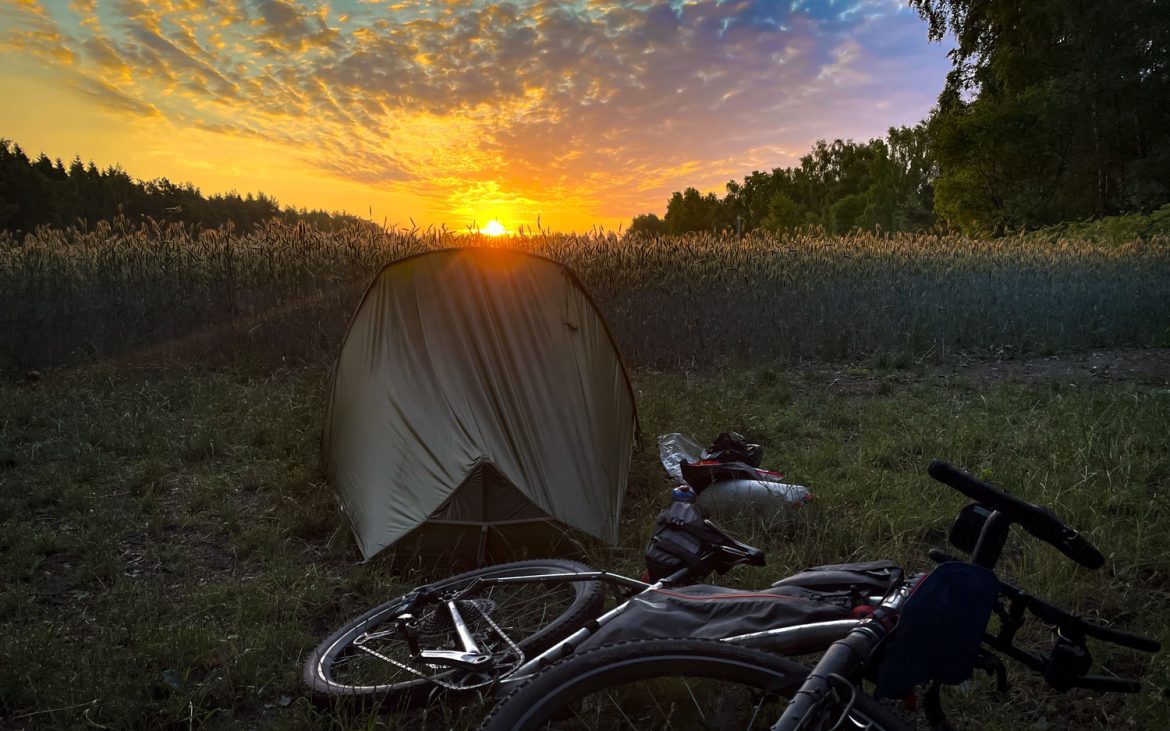
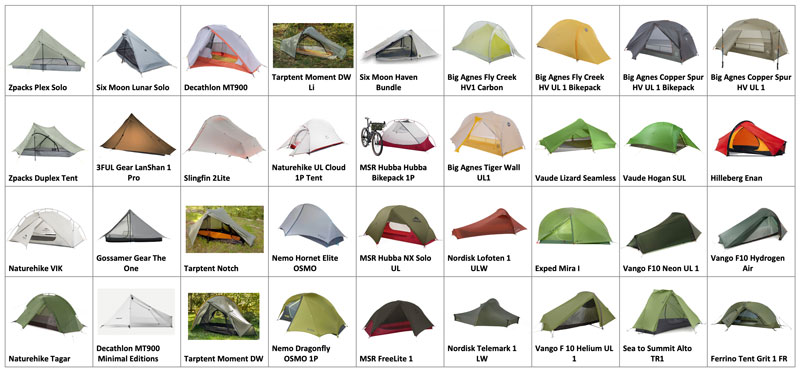
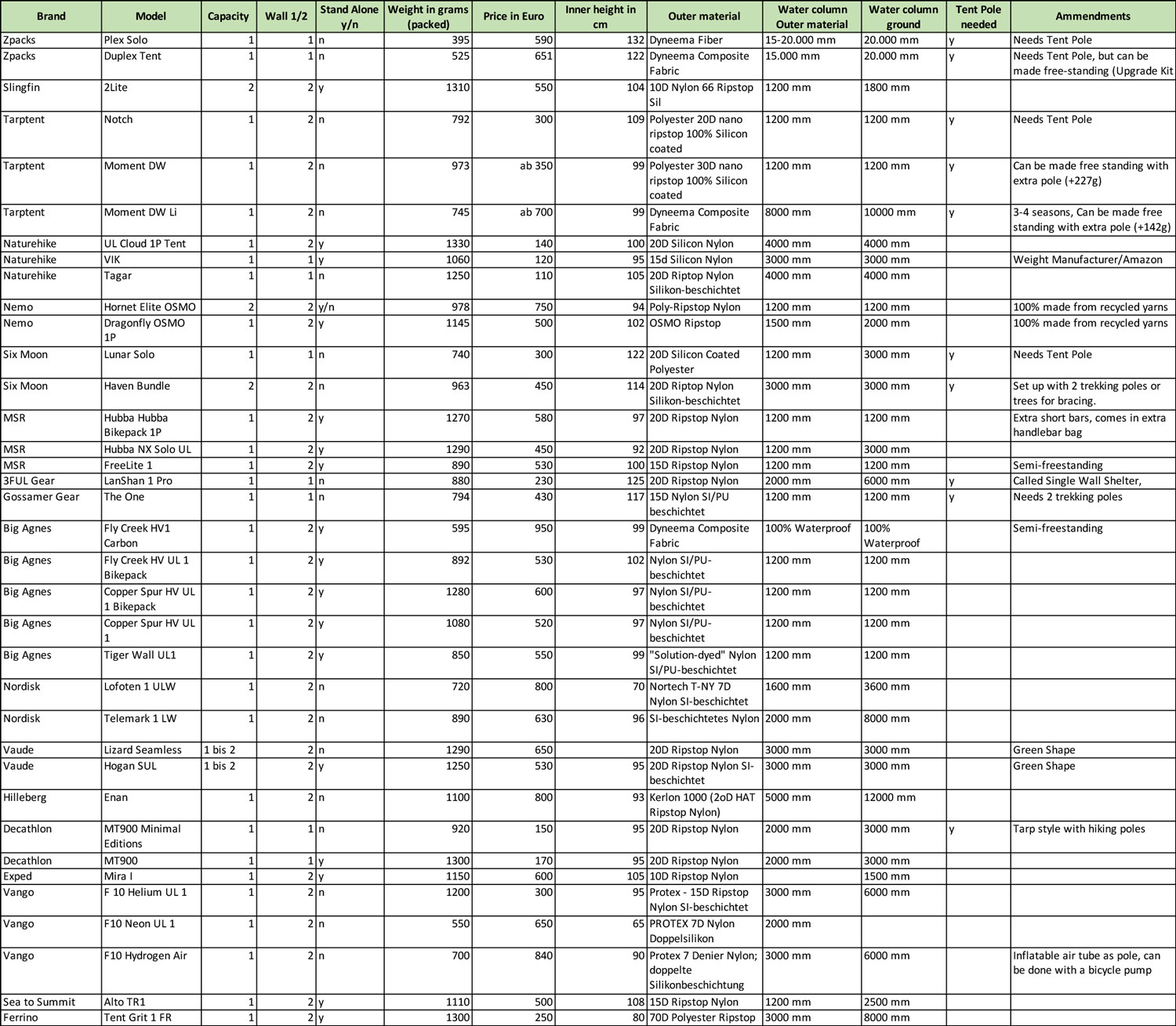
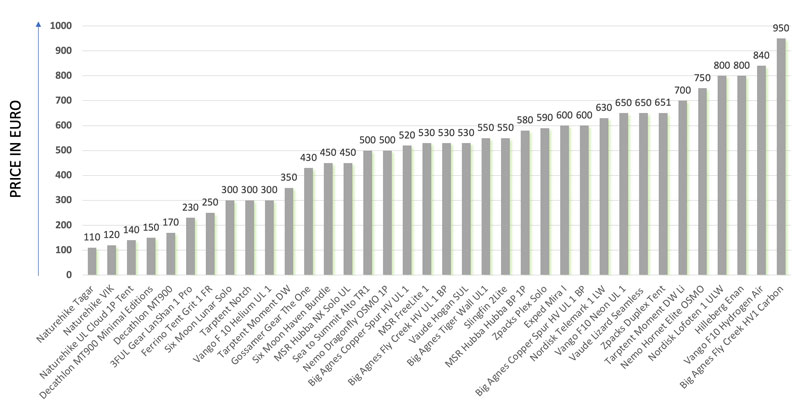
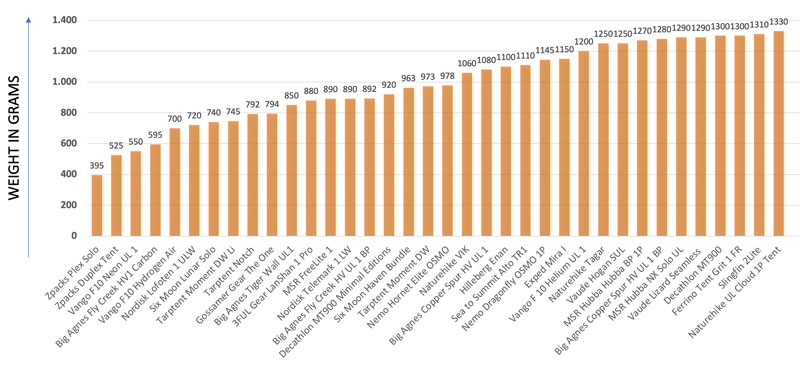
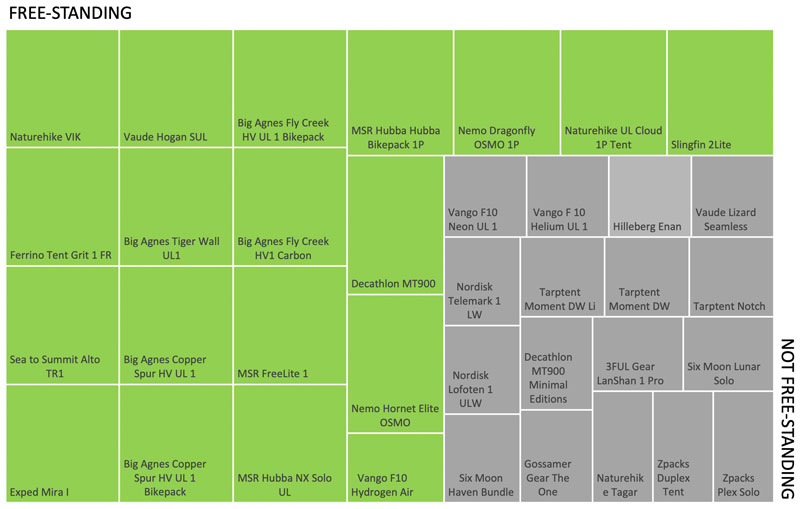

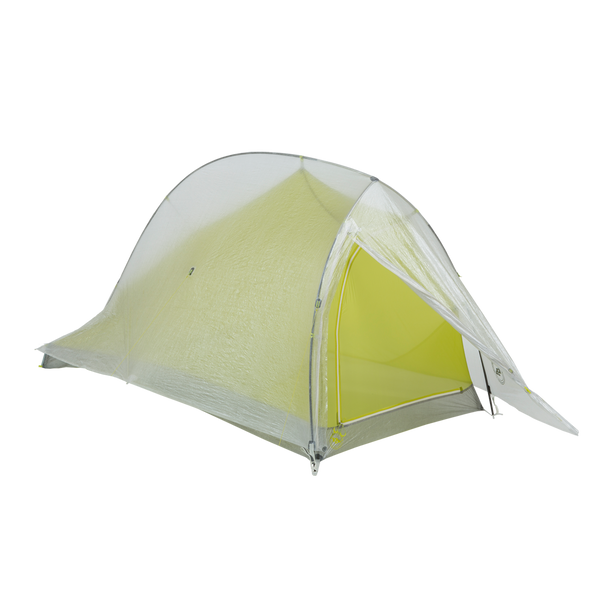
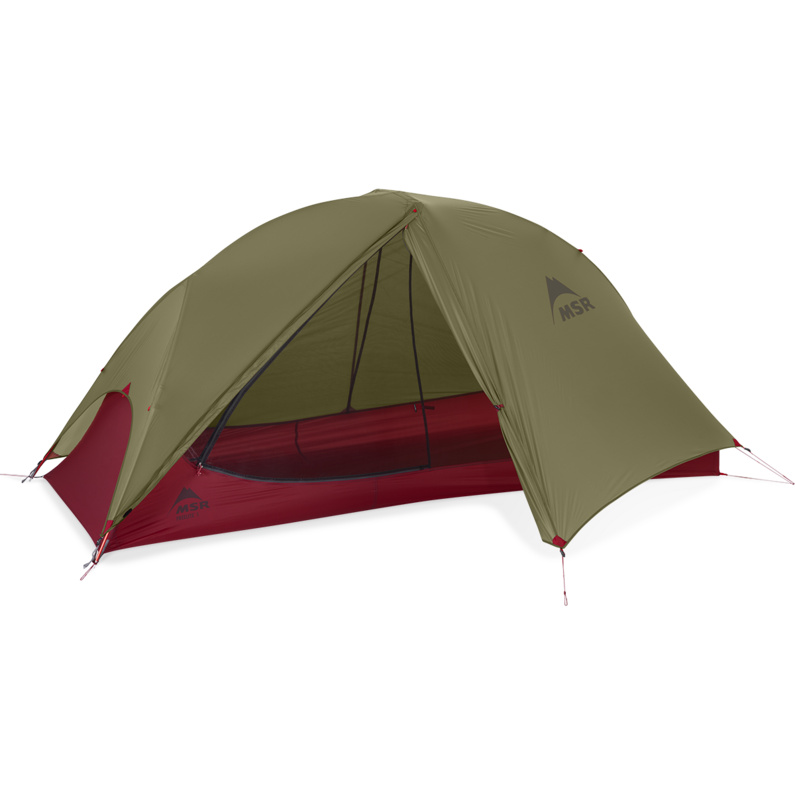

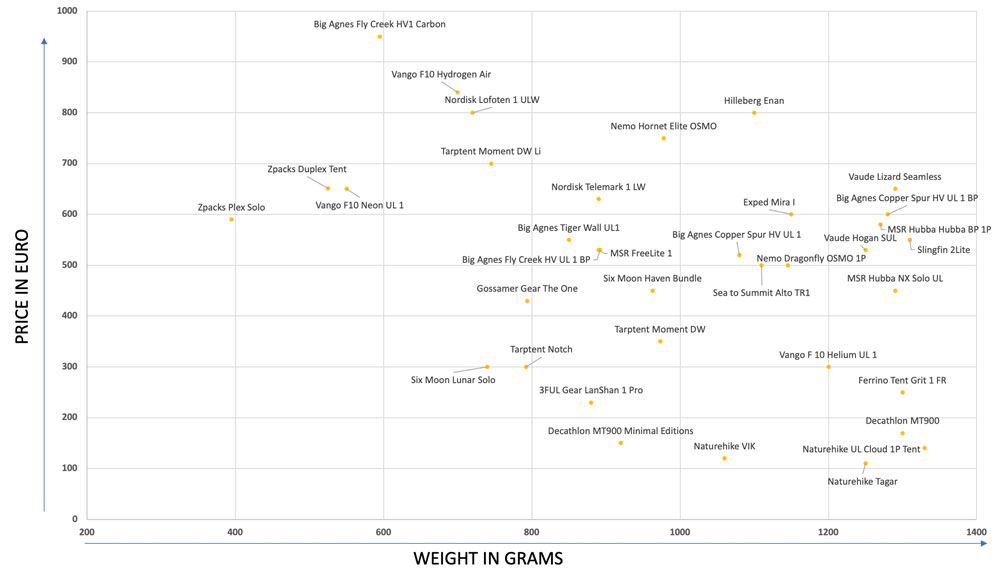
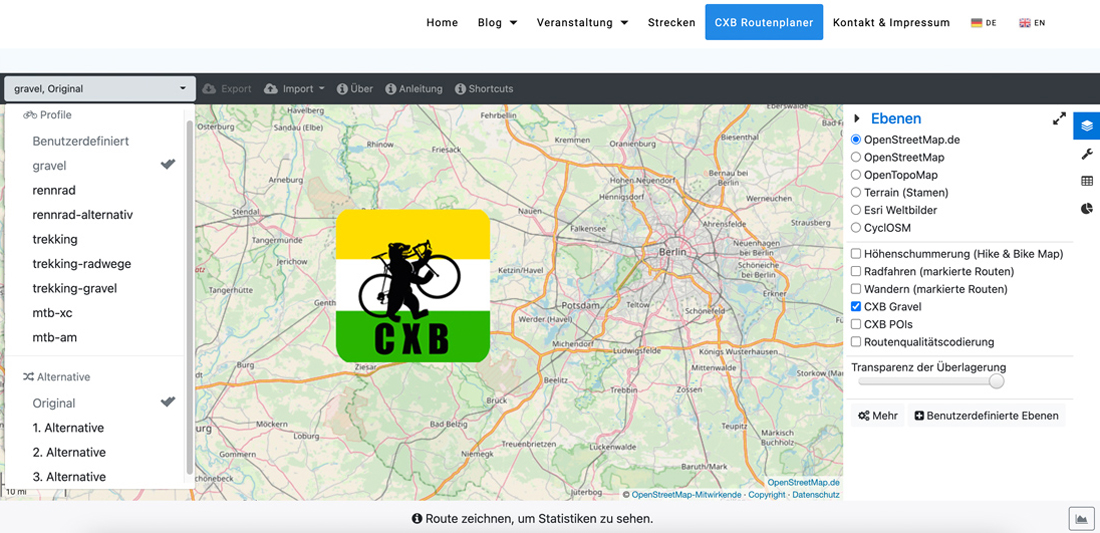

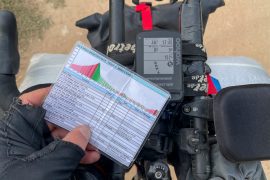
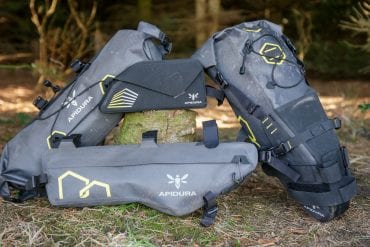
Wow thanks for this great comparison, you sharing this is much appreciated!
Is it possible to include the length of the tents?
Next time maybe.